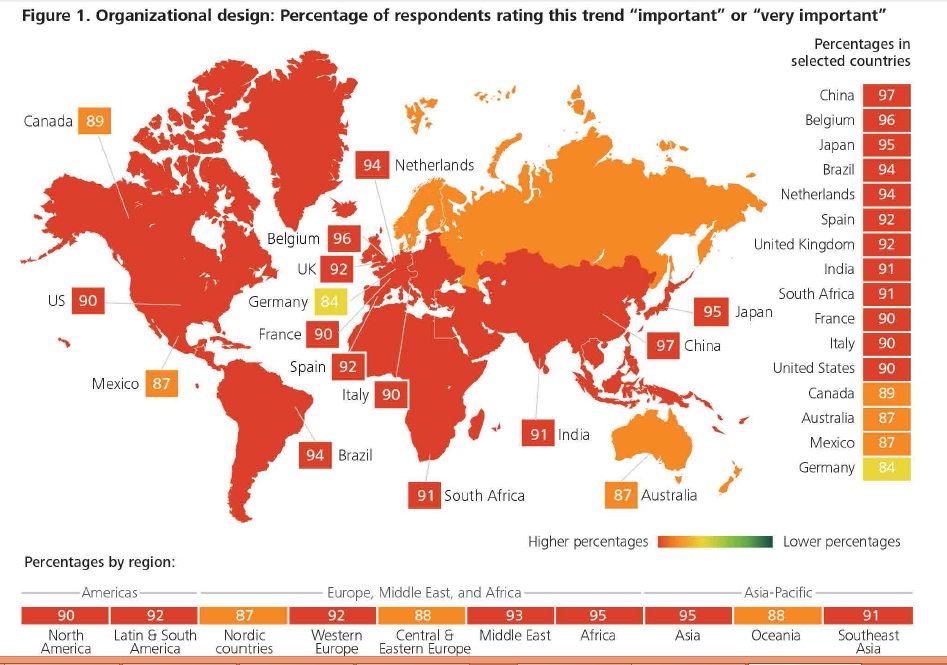The digital world of work is forcing radical changes in organisational structures and talent strategies.
Companies across the world are ready for an organisational structure overhaul. Around 92 per cent of the 7,000 business and HR leaders, interviewed by Deloitte, have opined that organisations need to redesign their structure to meet global business demands.
The views of Indian corporates were somewhat similar as 91 per cent of respondents from India said organisational design was important or very important.
Businesses have realised that it is time to become more agile and customer-focussed. To keep pace with this change, organisations are shifting their structures from traditional, functional models toward interconnected, flexible teams.
So what’s driving this change?
The pressure to get products to market quickly, combined with a generally greater sense of empowerment among the workforce, is making small teams a more natural and productive way to work.
Small teams can deliver results faster, engage people better, and stay closer to their mission.
Besides, the digital revolution helps teams stay aligned. Today, teams can easily use web or mobile apps to share goals, keep up to date on customer interactions, communicate product quality or brand issues, and build a common culture. Rather than having to send messages up and down the corporate pyramid, people can access information immediately, with companies using roles such as ‘liaison officers’ to make sure teams know what other teams are doing.
The Deloitte study, Global Human Capital Trends 2016, reveals that around 45 percent of the respondents claimed that their companies are either in the middle of a restructuring or planning one out.
Companies are now open to maintaining a network of teams, which implies that they are ready to build and empower teams to work on specific business projects and challenges.
Industry leaders foresee tomorrow’s workforce structured more like film-making projects, where individuals get together and work as a team for a project and later get dismantled. Simply put, the workforce of the future will work less like traditional corporates.
 However, a reality check of the situation revealed that only 14 per cent of executives believe their companies are ready to effectively redesign their organisations; While a mere 21 per cent feel they are experts at building cross-functional teams, only 12 per cent understand the way their people work together in networks.
However, a reality check of the situation revealed that only 14 per cent of executives believe their companies are ready to effectively redesign their organisations; While a mere 21 per cent feel they are experts at building cross-functional teams, only 12 per cent understand the way their people work together in networks.
The new workforce structure is writing a new social contract and changing the employee-employer relationship. This is being fuelled by rapid career growth, flexible work arrangements and an increase in the number of contract and part-time workers.
Leadership development
The senior industry leaders participating in the survey were of the opinion that the traditional pyramid-shaped leadership development model was passé and wasn’t effective in producing leaders as fast as the business demands. Around 89 per cent of respondents rated the need to strengthen, re-engineer, and improve organisational leadership as an important priority.
“Running faster on the traditional leadership development track will not solve this perennial challenge,” says Brett Walsh, global human capital leader, Deloitte Touche Tohmatsu Limited.
More than half of surveyed executives (56 per cent) report that their companies are not ready to meet leadership needs. Only 7 per cent state that their companies have accelerated leadership programmes for millennials, although 44 per cent report making progress—a jump from 33 per cent last year.
While investment in leadership development has grown by 10 per cent since 2015, progress has been uneven.
In fact, more than one in five companies (21 per cent) have no leadership programmes at all.
Corporate culture
The balance of power continues to shift in favour of the employee, causing business and HR leaders to focus on enhancing the employee experience, to help attract and retain top talent.
Close to 86 percent of the respondents rate challenges with corporate culture as ‘important’ or ‘very important’. In addition, 85 per cent rate challenges with employee engagement as ‘important’ or ‘very important’.
To address these issues, new roles are emerging within the HR function, such as ‘chief experience officer’ and ‘chief listening officer’. Companies are working on improving learning opportunities for all employees and closing the skills gap within the HR function.
Four in 10 executives report their companies are ready to address the skills gap in HR — an increase of 25 per cent since 2015. Moreover, people analytics is gaining speed to help improve this culture and engagement crisis.
This year, the percentage of executives that believe they are fully capable of developing predictive models doubled from 4 per cent in 2015 to 8 per cent in 2016, indicating rapid growth in analytics as a core discipline within HR.
The study further reveals that around three-quarters of executives (74 per cent) have identified digital HR—the complete redesigning of HR tools and services around digital technology—as a top priority.
42 per cent of companies are redesigning their HR systems to support mobile, just-in-time learning. 59 per cent are shifting their back-office HR systems to the mobile in an effort to make them user-friendly for the employees.




1 Comment
please send me the newsletters H R Katha to my email mentioned below